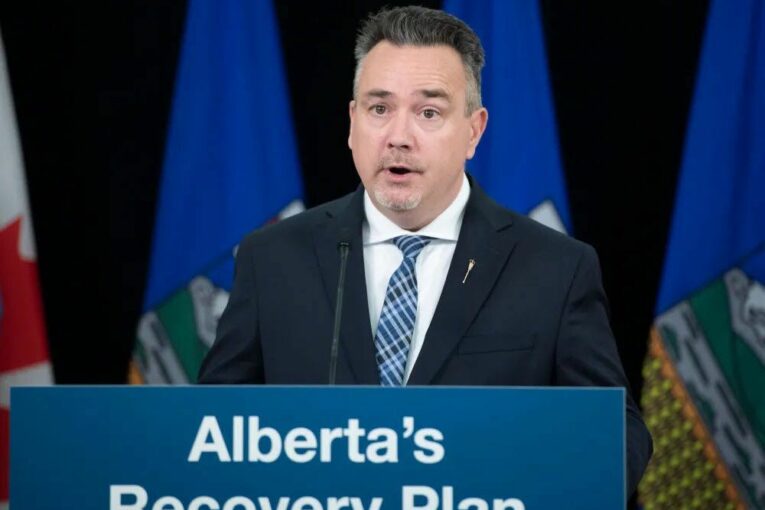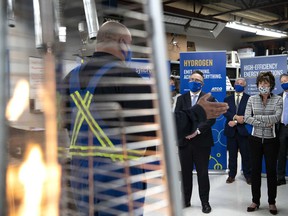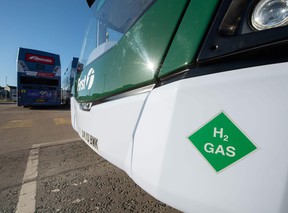
[ad_1]
If you want to know how big the potential prize is for Alberta to grow its hydrogen industry, Associate Natural Gas Minister Dale Nally is quick to provide the answer.
Think of the oilsands, he says.
Nally’s new Alberta Hydrogen Roadmap, to be released Friday, details a number of ways to measure success in the province for the emerging sector under a “transformative” future outlook.
It projects tens of thousands of jobs created during the construction of new projects, Alberta’s GHG emissions falling by five per cent and more than $30 billion in capital investment being attracted by 2030.
“For me, that is the minimum. I think we could do well more than that,” Nally said.
“This is an opportunity for Alberta to create generational wealth for the province. We have an opportunity to be a leader in clean, affordable energy.”
There is no denying the keen interest in developing hydrogen in a world acutely focused on decarbonizing energy systems. Hydrogen, which doesn’t directly emit carbon dioxide when used, is seen as a prime energy opportunity for the province.
Several proposed projects provide a tantalizing hint of what could be in store in the years ahead.
In May, ATCO and Suncor Energy announced plans for a project that would produce 300,000 tonnes of hydrogen annually. Air Products rolled out a proposed $1.3-billion net-zero hydrogen production and liquefaction complex in Edmonton the following month.
In August, Petronas and Japan-based Itochu unveiled a development that could see the companies build a $1.3-billion facility in Alberta that would export ammonia as a hydrogen carrier to markets in Asia.
Just last month, pipeline giant TC Energy announced it will work with electric truck manufacturer Nikola to co-develop and operate low-carbon hydrogen production hubs in North America.
More announcements are coming.

Nally compares the potential for Alberta’s hydrogen sector to the opportunity presented to the Lougheed government in the 1970s by the oilsands industry.
“It will not replace the oilsands, but I absolutely believe it could be as impactful as the oilsands, in terms of investment, in terms of jobs, in terms of royalties,” said the Morinville-St. Albert MLA.
The provincial blueprint, which Nally discussed Thursday at a net-zero emissions conference held by Petroleum Technology Alliance Canada, aims to leverage the existing advantages Alberta already has in this area.
Canada is one of the world’s largest manufacturers of hydrogen. Alberta produces about 2.4 million tonnes of hydrogen annually, primarily for industrial purposes.
It’s estimated hydrogen could provide up to 24 per cent of global energy demand by 2050 as the world pivots towards a net-zero emissions future.
The roadmap describes Alberta’s hydrogen ambitions in domestic markets — growing in transportation, residential and commercial heating, power generation and storage, as well as in industrial applications.
It has even bigger aspirations for the export market. “With an estimated global market of $2.5 trillion by 2050, hydrogen can be the next great energy opportunity for our province,” Nally told the conference.
The Transition Accelerator, a non-profit group based in Calgary that examines the shift to net-zero energy, has estimated hydrogen could create an estimated $100-billion-a-year market for Canada.
Alberta also has existing expertise in the energy sector, massive natural gas reserves and the geology necessary for carbon capture, utilization and storage (CCUS) projects to sequester emissions created to make so-called blue hydrogen.
(Green hydrogen is produced from water in a process powered by renewable or low-carbon electricity.)
“We are agnostic to the colour of hydrogen, as long as it’s clean hydrogen,” Nally said at the conference. “It will be industry that decides the colour of the hydrogen.”
The minister said one key challenge to overcome will be the cost to produce hydrogen, although the International Energy Agency said recently it’s expected to fall over time as the sector gains economies of scale.
The blueprint identifies several policy pillars for Alberta to pursue.
These include building new demand for hydrogen, enabling cost-effective CCUS projects needed to store emissions, as well as de-risking early investments. The study also focuses on promoting technology, ensuring a modern regulatory framework is in place and pursuing exports.
If hydrogen is widely integrated into Alberta’s energy system, the province could cut its emissions by 14 megatonnes annually by 2030, the blueprint states.

A separate report released Thursday by the University of Calgary’s School of Public Policy says hydrogen and its derivatives can play a key role in some emissions-intensive sectors, such as steel, chemical and clean fuel production, and long-haul transportation.
Hydrogen has the potential for “broad participation” across the country, thanks to the ability to produce hydrogen from natural gas and from clean electricity, the report says.
Another study by the school notes Alberta also has advantages that make hydrogen a feasible way to decarbonize the electricity grid.
Business Council of Alberta president Adam Legge said the province has many strengths to capitalize on, although there are issues to address, such as ensuring the industry has enough skilled workers, providing investment certainty and approving infrastructure needed to get product to market.
Last December, Ottawa put out its own blueprint that aims to establish Canada as a global supplier of hydrogen. Having the federal and provincial governments headed in the same direction is important, Legge added.
“Everybody recognizes there is a huge potential in hydrogen, but we do have to make sure we get some of the key pieces lined up before we really recognize the mass potential,” Legge said.
At the PTAC conference, David Layzell with the Transition Accelerator said another key challenge is to ensure adequate demand for hydrogen is in place as the industry grows supply.
But he agrees Alberta’s prospects for hydrogen are significant because the world needs to embrace major changes to develop net-zero energy sources.
“It is as big an opportunity for Alberta today as perhaps 50 years ago when Peter Lougheed was looking at the oilsands,” Layzell said in an interview.
“We have got to make it work — and we have to demonstrate that it can work.”
Chris Varcoe is a Calgary Herald columnist.
[ad_2]
You can read more of the news on source
